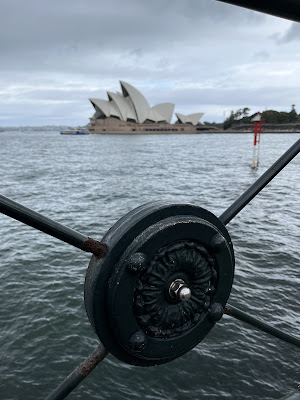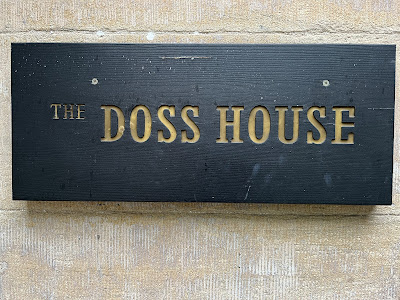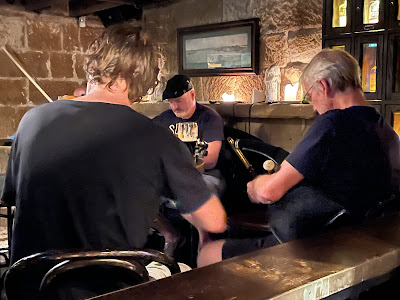I'm going to the UK to visit the folks. 'They' say that cats know things. Do they though?
Out on a morning jog I found a clump of agapanthus (favourite flowers among certain family members) and several trees which have been blown down in recent storms, including some which are still blocking the road.
Before heading off for a weekend in Sydney (prior to departure), there are still some samples from The 12 Days of Ginmas that need to be drunk - I'd hate to shirk my duties, so here are a couple with suitable garnishes
In Sydney, before we head to the SCG for the cricket, the first port of call has to be breakfast in Surry Hills - at a little street-side cafe, Four Ate Five to be precise.
 |
| Shakshuka |
 |
| Bea roll with cappuccino |
As the eagle-eyed among you can see from that scoreboard, things weren't exactly going superbly for England, but we did get to see Jonny Bairstow achieve a century in the last innings of the game on Day Three, and avoid the follow-on.
Walking back to the hotel we passed a couple of mural and pubs, some of which we stopped to investigate further.
 |
| In the rooftop bar of the Keg & Brew |
Watching cricket all day is tough work, so I need to fortify myself in the morning with a good healthy breakfast.
 |
| Granola bowl at Le Monde Cafe |
Kids at the cricket are hilarious. Apparently attitude becomes before ability, but at least they can say they've played at the SCG, and no one can take that away from them.
 |
| Seeing it like a football |
We had a great day watching Jimmy and Draco (Stuart Broad) bowl, and Warner and Smith both get out. The weather certainly had a part to play and it did so like a pantomime villain.
Once again the walk back from the cricket took us past murals and conveniently-placed pubs (The Local Taphouse in Darlinghurst) and restaurants (Fat Thaiger).
 |
| Chicken Pad Thai |
 |
| Beef Massaman Curry |
We didn't have tickets to the last day of the cricket, so we spent the day wandering about bits of Sydney and seeing some arty stuff.
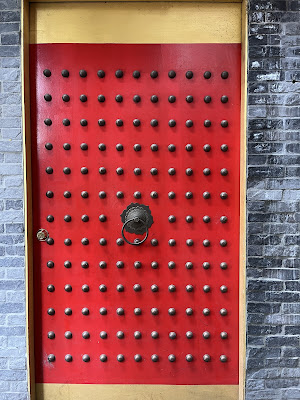 |
| A door in Chinatown |
These inflatable sculptures in Darling Harbour are part of the Airship Orchestra installation by ENESS for the Sydney Festival. Interactive and multi-sensory, they pulse with light and glow with supernatural song to create immersive environment in a public space.
Meanwhile there are floating sculptures in Cockle Bay, which are large scale representations of some of the trillions of tiny organisms and creatures which exist in their tiny worlds below the water. Macrocosm by Goldberg Aberline Studio is a giant, technicolour artwork of designs printed onto lightweight 'green' fabric made from recycled PET drinking bottles, drawing attention to a clean ocean theme. Maurice Goldberg, one of the designers, says, "We wanted the work to be like an explosion of creativity, overflowing with scribbles and paint splotches... It was important to us that in this very digital era, the work was obviously handmade... by humans."
The artwork Remembering runs along the base of the building. Artist, Danie Mellor writes of the work,
"I respectfully acknowledge the Gadigal people and their custodianship of the land on which Remembering is shown and am grateful for the support of the many people involved in the creation of the artwork.Remembering shows a landscape of Gadigal country as it may have appeared prior to colonisation. The environment in the work reflects the indigenous flora of the Sydney region, with elements of the Barangaroo Reserve an integral part of its composition. Affirming and responding to the memory of Cammeraygal woman Barangaroo and the significant role of Aboriginal women in community, figures of female dancers are dynamically present on the land.The combination of otherworldly infra-red and visible light imagery suggests we are looking into a timeless Story Place, a land remembered in which the physical world meets a dimension of Dreaming. Remembering responds to potent themes of Country, People and Language, exploring our continuing relationship to place, ancestors and nature."
This is an intriguing part of the city, with layers of history and geographical features. A contemporary re-imagining of Welcome to Country is depicted through a ten-minute audio visual artwork, Wellama by Alison Page and Nik Lachajczak, commissioned for the entrance to the Cutaway in Barangaroo Reserve. Wellama means 'to come back', and the artwork welcomes visitors to Gadigal Country and pays respect to the Traditional Custodians of this land.
 |
| Nawi Cove |
 |
| Wellama |
Continuing around the Walsh Bay Sculpture Walk, we encountered several interesting installations.
 |
| String Theory II by Lorry Wedding-Machioro |
 |
| Sea Mare by Stephen Coburn |
 |
| Conversations by Phillip Piperidis |
 |
| Link 5 by Mike Van Dam |
By then we needed food, so we stopped off at Brix and Beans Coffee House for a spot of breakfast. This is apparently also a film set location for The Matrix; a plaque on the ground announces that Trinity makes a phone call and escapes from the Agents before the phone booth is destroyed. I'm sure that means something to someone out there.
We walked around Dawes Point past the iconic Sydney landmarks, until we got to the Museum of Contemporary Art, where I popped in to see some exhibitions.
 |
| Moore Stairs |
On the steps leading up to the Museum of Contemporary Art, visitors are welcomed to the space by a work commissioned from the artist Vincent Namatjira in 2021. He hand-painted P.F.F. (Past-Present-Future) directly onto the 15-metre wall to create a vibrant work depicting a group of seven Aboriginal male figures, including a self-portrait, painted on the desert landscape of the artist's home community of Indulkana in the Anangu Pitjantjatjara Yankunytjatjara (APY) region in South Australia.
Each portrait has been painted in Namajtira's signature-style caricature and the painting incorporates influential figures in his life including AFL football player and 2014 Australian of the Year Adam Goodes, land-rights campaigner Eddi Koiko Mabo, bantamweight boxer Lionel Rose, his great-grandfather Albert Namatjia, and himself standing on the roof of his great-grandfather's Holden ute.
 |
| P.P.F. (Past Present Future) by Vincent Namatjira |
The touring exhibition of Doug Aitken, New Era, was interesting in its interpretation of words as images. He aims to 'pull words down from their landscape and bring different meanings to them; short circuit them; reflect on them'. He says he is fascinated by language but he sees it as becoming faster, shortening up and becoming abbreviated, therefore he feels he uses language like short phrases or haiku. He is interested in how single words and short phrases can take on multiple meanings and transform, allowing them to express something that they hadn't previously.
Depending on the angle at which the viewer stands to interact with these works, they will see different reflections or through new gaps and spaces, which may close with movement.
 |
| END/RUN (timeline) 2014 |
The exhibition itself is like a kaleidoscope spanning many different locations, media and ideas, and the artist wanted to create an exhibition that the viewer could fall into and become immersed in. The idea is that each person will see it differently depending on the perspective they bring and the narrative they tell. He wanted to turn the museum inside out so the viewer could get lost within it and have their own discoveries within the works.
 |
| NOW (dark wood) 2016 |
There are several video installations, one filmed under the Pacific Ocean, another inside the diamond mines of Namibia. Other works use physical qualities, such as the Sonic Fountain in which you find a room where the floor is excavated and water drips or cascades from the ceiling creating a musical composition. Migration is a work filmed across North America entirely in motel and hotel rooms, with a different indigenous species introduced into each space - a mountain lion, a bison, an owl or jack rabbits. He wanted to point out the repetition that we create in our cities so that you could fall asleep in a hotel and not know what city or country you were in, and then see what happened when a natural species was introduced into this synthetic environment.
A wall of framed photos hangs on plywood to make up 99c dreams. This collection of images stacked four high and 22 long is then repeated with several hundred works to encompass the full length of the corridor space of the MCA. They collectively offer 'a voyeuristic wander through what feels like a journal - snippets of the banal, or every day.' From nighttime cityscapes to deserted petrol stations, airports and bus depots, his dreamlike peopled and unpeopled photographs contain a spatial and temporal dislocation. It has a sense of quiet melancholy and Aitken has described it as 'intentionally rudderless' as the viewer walks past several pictures before finding those that resonate individually. You can see how childish I am by my choice.
 |
| 99c dreams |
There were other works in the gallery that caught my eye. Kalyu is a work depicting a vast area in the Pilbara region of Western Australia that encompasses the Martu Aboriginal communities of Parnngurr and Punmu, and represents the Martu Native Title determination area in its entirety. Painted by nine artists from Parnngurr, it reflects the Martu people's intimate knowledge of their desert country.
The work is a map in the most expansive sense. Representing the landscape from below the ground to above the surface, it brings together aspects of geography, cultural knowledge and seasonal time. Through carefully sequenced layers, the painting documents the fragile, interdependent relationships between different environmental elements, indicating how the hidden underground waterways (kalyu) play a vital role in the biodiversity of the area.
Kalyu was made in protest against uranium mining exploration taking place on the edge of Karlamilyi National Park, which continues today. The National Park is exempt form the 2002 Martu Native Title determination yet is considered by the artists to be 'the heart of Martu Country'.
 |
| Kalyu |
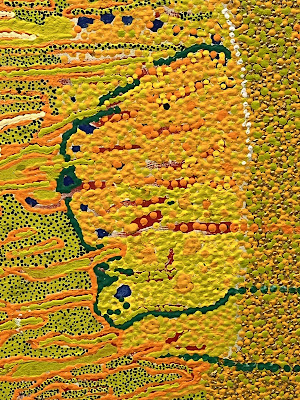 |
| Detail from Kalyu |
Foundations III relates to the history of Aboriginal middens along the eastern seaboard of Australia, including at Tallawoladah - the rocky headland of Warrane (Sydney Cove) where the MCA is located. Middens are mounds formed from the residues of communal and cultural life. In coastal areas, they commonly include the shells of native oysters. The mounds represent a cumulative record of occupation over millennia and the artist, Megan Cope, considers them a form of Aboriginal architecture.
Cope's choice of materials (native oyster shells and cast concrete) refers to the destruction of middens during the early colonial period, when they were mined by white 'settlers' for limestone, which was then burned to make mortar for buildings. This practice was integral to establishing the colony at Tallawoladah, which has since evolved into an urban grid: a formation echoed in the serial arrangement of the work.
 |
| Foundations III by Megan Cope |
 |
| Goowoolem Gijam - Gija plants (2013-16) by Shirley Purdie |
This suite of paintings by Shirley Purdie depicts plants of the East Kimberley region of Western Australia used for food, medicine and object making. Conceived as a botanical encyclopaedia, the work preserves vital cultural memory and information that has been passed down through generations of Gija people. It is the result of years of research by Purdie who worked with linguist Frances Kofod to document individual plant species and record their Gija, Latin and English names: an exercise in cultural continuity and exchange.
 |
| Detail from Goowoolem Gijam - Gija plants |
"I made these paintings about the things I saw when I was growing up. They show the things my old women told me. They are about bush food, the things we can eat in the bush, fruits like black plum and that kind of thing and bush honey. Others that I painted show those trees to make artefacts like fighting sticks, digging sticks and coolamons. Other paintings show the grasses that people used to make the spinifex resin that they used to join axe heads to the handles."
 |
| Milŋurr Ŋaymil font (2019) by Gunybi Ganambarr |
Milŋurr Ŋaymil font identifies the reservoirs of the Ŋaymil/ Datiwuy clans in an area between the Gurrumuru River and Cato River in the Northern Territory. These include freshwater springs (Milŋurr), lagoons and floodplains. Among them is a sacred Milŋurr associated with fertility, birth, and the passing of souls between the physical and spiritual worlds.
The elaborate carved patterns in the work refer to the movement of ripples across water made by the water surging from underground. It is a clan pattern that belongs to this place. Dhangultji (brolga), Djanda (goanna) are found here and also Warrukay (barracuda), which swim up from the saltwater in Arnhem Bay.
Ganambarr is a key figure in the 'found' movement of north-east Arnhem Land, in which industrial materials are reclaimed from the land and incorporated into art making alongside inherited artistic practices. The aluminium panels used here were retrieved from building works at a local school.
 |
| Detail from Milŋurr Ŋaymil font |
Seine River Basin explores the chemical history of the River Seine and its adjoining waterways, the River Marne and the Saint-Denis Canal. During an extended residency in Paris, the artist Yasmin Smith collected pieces of tree wood from along the banks (berge) and in the water (flotté) at different locations. She then created ceramic replicas of these specimens, before burning the woods down to make ash glazes for the cast forms.
In the final installation the branches are arranged in two rows that suggest trees on a riverbank and their reflection in the water's surface. The glazes contain visual traces of the chemical elements that had leached into each piece of timber from the soil and water, and remained lodged in its cellular structure like memories.
 |
| Seine River Basin (2019) by Yasmin Smith |
Sam Gold likes to use art as a therapeutic tool for healing, catharsis and unravelling our experiences that we have in the world. She believes our biology writes our biography and uses ceramic sculptures of stoneware, porcelain, raku and terracotta to express the healing processes of gesture and repetition undertaken within the human body when dealing with trauma or adverse experiences. She explores tactile and somatic storytelling through a pinching style that she has expanded into wave-like forms that extend upwards and outwards indicating the notion of endurance.
Delicate ripples of clay fold across the organic shapes, reminiscent of coral or termite mounds. Their surface is marked by the artist’s repeated finger impressions, timestamping the connection between maker and material. Intricate crevasses within each work resemble the complexities of human physiology and experience; the clay body and the human body mimicking each other and learning their physical boundaries throughout the process.
"The body to me is this world of discovery that is talking to us constantly, our body is a safe place, a home, a really remarkable vessel of thousands of stories, our cells have memories and I suppose that is the very reason I choose clay as a material- its capacity to never forget- to always recall- to remember a push or a pull or a knock will always show, no matter how much you try to fix or conceal all is bared."
 |
| Primavera by Sam Gold |
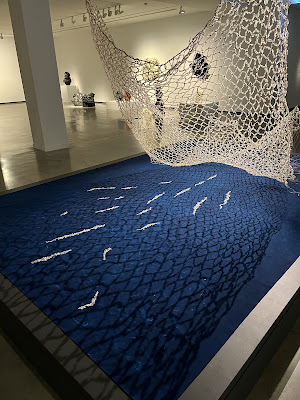 |
| a search for meaning is to absorb the abundance of beauty in nature (2021) by Elisa Jane Carmichael |
This new work comprises a generous, hand-woven and functional fish net suspended above its silhouette on cyanotype (a photographic printing process). Weaving is a way for Carmichael to stay connected to her matrilineal ancestors; by continuing their techniques, she keeps her culture vital and alive.
Carmichael's net is made form the inner bark of the talwalpin (cotton tree), a valuable resource found on her Country, Mulgumpin (Moreton Island) and Minjerribah (North Stradroke Island), Queensland. The talwalpin was stripped and strung into string for weaving, then delicately threaded with thousands of pearlescent fish scales, adding yet another layer of connection to her homelands. The rich blue hues of the cyanotype are reminiscent of the deep abundant waters of Quandamooka Country.
"Our Country and waters are alive, holding an abundance of memories, life and materials to sustain us when we look and listen to our budjong djara (mother earth), Our muyan (skin) and bajara (footprints) will be present gubagulabu (forever)."
 |
| Detail from a search for meaning is to absorb the abundance of beauty in nature |
The shape of A Secret World of a Starlight Ember is egg-like: eggs are about beginnings – the beginning of life itself. During the day, the work reflects the pageantry of life around it. People are reflected in it, dissolving into the reflections of the harbour, the buildings, the sky, emphasising how humans are part of nature. At night, the work emanates light – shimmering like star dust, throwing shadows beneath it. The work hovers in space, drawing people toward it, transforming the public space.
"I'm intrigued by this beautiful reality that we still receive the light of stars that were born and died millions of years ago. For me, that is a beautiful analogy of life; our lives are finite, even the stars are finite. Each life has a resonance and has this ripple effect that goes on beyond us. Secret World of a Starlight Ember represents each and every one of us; the secret world is our secret lives in every moment that we exist … We ripple out into the world and the world ripples into us. And that's how life is formed, that's the dynamism of life."
 |
| Secret World of a Starlight Ember by Lindy Lee |
 |
| Kendall Lane, The Rocks |
 |
| Floating lanterns by Goldberg Aberline Studio and Graham Toomey |
The rain was continuing to affect the cricket (and my hair), so we planted ourselves at a pub with great views (The Squire's Landing) and celebrated the last day of the pink test by drinking pink bubbles and alternating between watching the skies and watching the television when there were any balls being bowled.
The ending of the cricket match was amazing - it all came down to the arguably the best batter in the world bowling to the best bowlers. Due to the poor light, the umpire deemed that Pat Cummins couldn't continue to bowl and Australia had to put in another (non-fast) bowler to try and get the one wicket they needed. Steve Smith and Nathan Lyon bowled to Jimmy Anderson and Stuart Broad who had to hang on for three overs to draw the series - they were battered and surrounded with every ball a nailbiter, but they did it in what has to be the most thrilling draw I've ever seen.
Our celebrations then took us to an amazing little heritage whisky bar underground in The Rocks called, The Doss House - obviously Him Outdoors had to pose for lots of photos.
The site formed part of Sydney's first convict hospital and gardens. A plaque outside records the words of Arthur Phillip, Commander of the First Fleet from Portsmouth England to Botany Bay Australia. "A building for the reception of the sick was now necessary and one, eighty-four feet by twenty-three, was put in hand, to be divided into a dispensary... a ward for the troops, and another for the convicts."
Now the stylish vintage interior includes Chesterfield armchairs and a fiddle band - perfect surroundings to enjoy some fine whiskies as recommended by the knowledgeable and engaging bar staff.























































